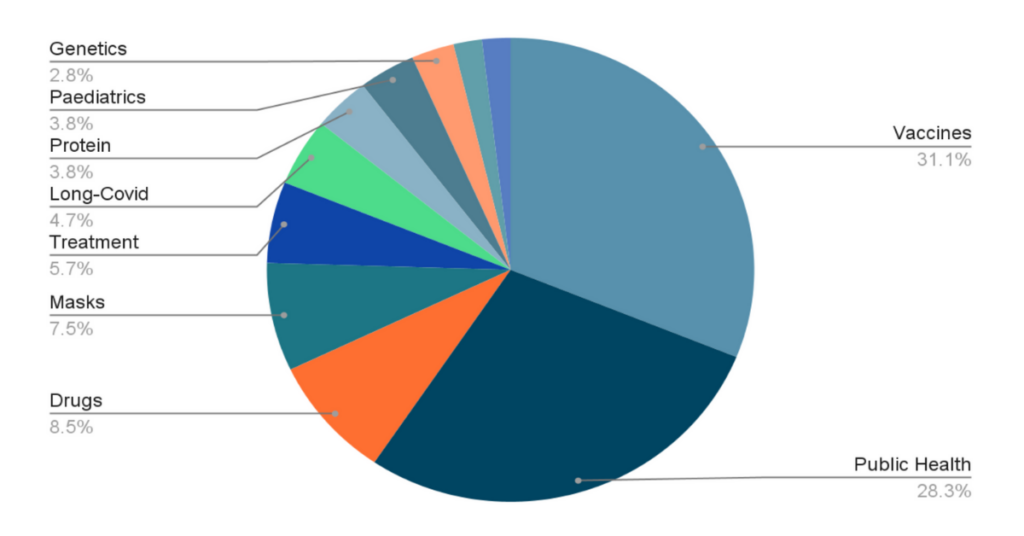Top 100 2021 – the Old School Remix

Re-imagining the Altmetric Top 100
Many of you will be familiar with the annual Altmetric Top 100. Launched in 2013, this list highlighted the most-mentioned scholarly publications from the year, and featured much-discussed topical research that had caught the wider public’s imagination.
Since its launch, the Top 100 has demonstrated the influence and reach that it is possible for research to have – and through our data we have shown that communicating beyond the academy is critical to the broader dissemination and application of academic study.
Given the evolving landscape of research communication and analyses, we have decided it’s time to refresh our annual review of society’s engagement with research. Instead of continuing to produce a typical ‘Top 100’, in future years we will focus our analyses on the unique opportunities our data offers: identifying emerging trends, highlighting examples of great engagement, and encouraging researchers to communicate their research and its outcomes as effectively as possible.
As a result of this change we will not be producing an official Top 100 this year.
But fear not! As a final farewell to the original lists, Altmetric’s Head of Data Insights, Mike Taylor, will be sharing a series of blog posts that each take a different approach to compiling a ‘top 100’ – and analysing the data to draw out the key considerations of each approach.
Following the blog series we will be in touch with various customers and users within the community to obtain their thoughts, ideas and inputs to help us shape the future report.
Read on for Mike’s first take on the data this year…
Top 100 2021 – the Old School Remix
Last year, we decided to approach the Top 100 from a new perspective, by introducing classification by subject areas: this was, in part, a response to the circumstances thrown at us by COVID19, and also a need to be informed by the insights that have emerged following a decade of academic research into altmetrics.
The extent to which altmetrics vary by subject discipline is extremely well known, and was one of the first phenomena to have been thoroughly investigated by researchers in the early days of altmetrics. The fact that differences existed at all wasn’t a surprise: citation counts are also known to vary by discipline. In fact, there are more types of variation: not only does the volume of citation count vary, but so does the speed and duration of citations change. The same is also true for altmetric data: with the added complexity that we have to account for over a dozen sources of attention – all of which have their own unique variations.
In the years pre-COVID, the Top 100 was based entirely on the Altmetric Attention Score, while last year we took the choice to segment our list based on discipline.
This year, uniquely, we’ve chosen to present three alternative views into the Top 100. In this – the first – blog, I’m revisiting the methodology we followed in the years preceding 2020, and looking solely at the Altmetric Attention Score.
Methodology and data
The methodology for this approach (which I’ve informally called the ‘Old School Remix’) only allows primary research articles – whether published in preprint archives or journals. In other words, we’re not looking at books, editorials, commentaries, reviews, and letters. We also chose to discount articles that have been retracted. You can find the link to the data on Figshare, there’s a public summary and – for Explorer subscribers – the full list is available, as a saved search.
The science bit
The Top 100 Old School Remix sheds light on one of the motivations for introducing subject areas last year: of this year’s top 100 research articles, 98 of them concern COVID19. This shouldn’t be too much of a surprise: pandemics happen rarely, thank goodness, but – by their nature – they can affect everyone in the world.
The two articles that aren’t about COVID19 deserve a special mention.
Bedriñana-Romano et al’s paper, Defining priority areas for blue whale conservation and investigating overlap with vessel traffic in Chilean Patagonia, using a fast-fitting movement model published Open Access in Scientific Reports elegantly combines conservation, real-time / big data, aquaculture and marine telemetry in a very accessible piece of research.
Merdith et al’s paper, Extending full-plate tectonic models into deep time: Linking the Neoproterozoic and the Phanerozoic, published in Earth-Science Reviews is possibly less accessible: both in terms of its subject matter, and not being Open Access. Nevertheless, the team of researchers brilliantly created a video that summarised their paper, condensing 1B years of plate tectonics into 40s of animation.
To have published articles in the second year of this pandemic that have stimulated so much public engagement is no mean feat.
So what attention did the Old School Remix Top 100 get?
- Over 2M tweets and retweets linked to one of these papers
- Almost 50k news story and blogs posts cited the research
- 482 videos were posted on YouTube
- 283 Wikipedia citations were made
- 277 Policy citations have been detected so far
The top 10 journals were:
- New England Journal of Medicine (17 articles, receiving 326k mentions)
- Morbidity and Mortality Weekly Report (13 articles, receiving 217k mentions)
- The Lancet (13 articles, receiving 275k mentions)
- Science (6 articles, receiving 137k mentions)
- JAMA (5 articles, receiving 81k mentions)
- Lancet Infectious Diseases (4 articles, receiving 55k mentions)
- Nature (4 articles, receiving 65k mentions)
- European Journal of Clinical Investigation (2 articles, receiving 68k mentions)
- International Journal of Infectious Diseases (2 articles, receiving 33k mentions)
- JAMA Network Open (2 articles, receiving 45k mentions)
The academic institutes in this version of the Top 100 were strongly international, with South African and Brazilian universities all featuring, representing the global effort the pandemic required. Highlights include the University of Oxford (13 outputs); London School of Hygiene and Tropical Medicine (7); Harvard University (6), University of the Witwatersrand (4), Centers for Disease Control and Prevention (4). University of California, San Diego (4), Pfizer (3), Hospital de Clínicas de Porto Alegre (3), and Sechenov University (3).
Within the 98 COVID articles, some trends are emerging. Whereas last year, the focus was largely on the origins, proteins and genetics of the SARS-CoV-2 virus, on the treatment of the COVID19 disease and the emerging vaccines, this year has largely focussed on the continuing vaccine development and public health policies. To help breakdown these articles, I created a simple taxonomy:

Vaccine research that received attention was much less focussed on novel vaccines, and much more on the long-term effectiveness, the extent to which they protect individuals, the degree to which they have reduced the prevalence of the virus and their effectiveness against variants-of-concern, such as Delta. Public Health research reported methods of transmission, examined the effectiveness of stay-at-home policies and other approaches. Research into the possible use of drugs such as ivermectin and hydroxycholoroquine received a lot of attention around the world. Two areas to receive much more attention in 2021 than in 2020 are masks and Long COVID. The benefits – to the population and the self – of wearing a mask were very hard to quantify early on: however, the science is now solid. Masks work. Sadly, for those who do catch the virus, Long Covid is also a reality, and researchers looked at physical, psychological and neurological issues following the initial treatment period.
Preprints, for all the importance they have played in COVID research, were not to be found in the Top 100.
Conclusion
The Old School Remix Top 100 does not lie: for the second year running, COVID research continued to be the area that has commanded the highest rates of interest. The simple fact is that COVID is of importance to all humans, and (as we might say) has ‘gone viral’ in all the attention sources we cover. Add to that, the speed at which research has been translated into policy has changed – possibly forever – the way in which we might see science expressed in society. But this might also give the impression that it’s the only area to gather attention, and that’s not a fair representation of what happened to scholarly communications in 2021: in fact, while COVID dominated biomedical-focussed attention sources, other areas of research have been actively discussed and continue to be influential.
My next Top 100 will revisit the methodology of last year’s Top 100, where we used subject area classifications to highlight the top most discussed research from a broader range of research.
Register here to receive the latest news and updates from Altmetric
